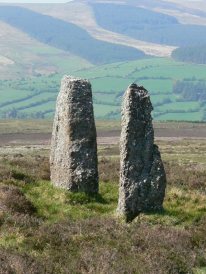Standing stones – their mystery and presence in the Irish landscape have questioned and fascinated people for centuries.
The county of Waterford in Ireland’s south east, has a rich legacy of these ancient megalithic monuments, the majority of which are located in the east of the county.These fascinating, if yet simple forms of monument, were a convenient prehistoric structure where no foundation was required, just some smaller packing stones were needed to secure and maintain their upright position through the ages. Some may have been shaped and sculptured to resemble figures while others can be found with an early form of rock art called a ‘cupmark’ or others with Ogham inscriptions believed to be the earliest form of Irish language.
 The Harp Stone at Whitfield North
The Harp Stone at Whitfield North
In Waterford, standing stones are sometimes found near Mounds, Ringforts or occasionally in the vicinity of Portal Tombs. They can also be encountered close to early church sites.
The reason for their placing in the landscape is uncertain as is the choosing of their location. Were they markers of ancient routes through the land, meeting places or perhaps territory indicators set down by the earliest farmers. Through excavation, some are known to have been memorials or grave markers as evidence of burials have been discovered at their base.
There are many impressive examples within the county and here you will find a mention of just a few of the numerous types which have been Archaeologically recorded.
To begin with, it would be remiss not to mention Ballymote ( below right) This is the  county’s tallest standing stone at 3.7 metres in height and is indeed a fine example which is sited close to a tumulus or mound. Here,there is every possibility that there may have been a connection between the two monuments.
county’s tallest standing stone at 3.7 metres in height and is indeed a fine example which is sited close to a tumulus or mound. Here,there is every possibility that there may have been a connection between the two monuments.
Besides single monoliths, there is also a number of Stone Pairs and Stone Rows in the county. Fine examples in this category include Ballyindysert, Knockboy and the wonderfully located stone pair at Knockanaffrin in the Comeragh mountains (pictured below).
It’s a bit of a climb to get to Knockanaffrin but certainly worth it, as it ranks as one of Waterford’s must see sites.
Another wonderful stone is the “Harp Stone” at Whitfield North. Standing upright with its Harp shaped profile, it dominates the field in which it is sited and stands majestically against the picturesque backdrop of the Comeragh mountains to the West.
Stones with Ogham inscriptions are also common in the county. A good example can be seen at Crehanagh South (below right) not far from Carrick on Suir.
 The stone stands 2 meters tall and its well preserved inscriptions are thought to be a later addition to what was once a basic standing stone.
The stone stands 2 meters tall and its well preserved inscriptions are thought to be a later addition to what was once a basic standing stone.
Within the county there are many more to explore and marvel at such as the high elevated “Stone Man” in the Bearna na Madra Gap and one of my favourites Pickardstown (pictured top) after a snowfall.
Standing next to such stones one gets a special feeling of a very distant past. They provoke the mind to speculate and urge one to try and visualise what it must have been like in the landscape in which they are standing all those thousands of years ago.
Despite an ever changing and modernising world, these stones remain. They have stood through the centuries and outlived human memory, leaving us to constantly ponder on their significance and on a past that holds many great mysteries.
To see more of Waterford’s standing stones

